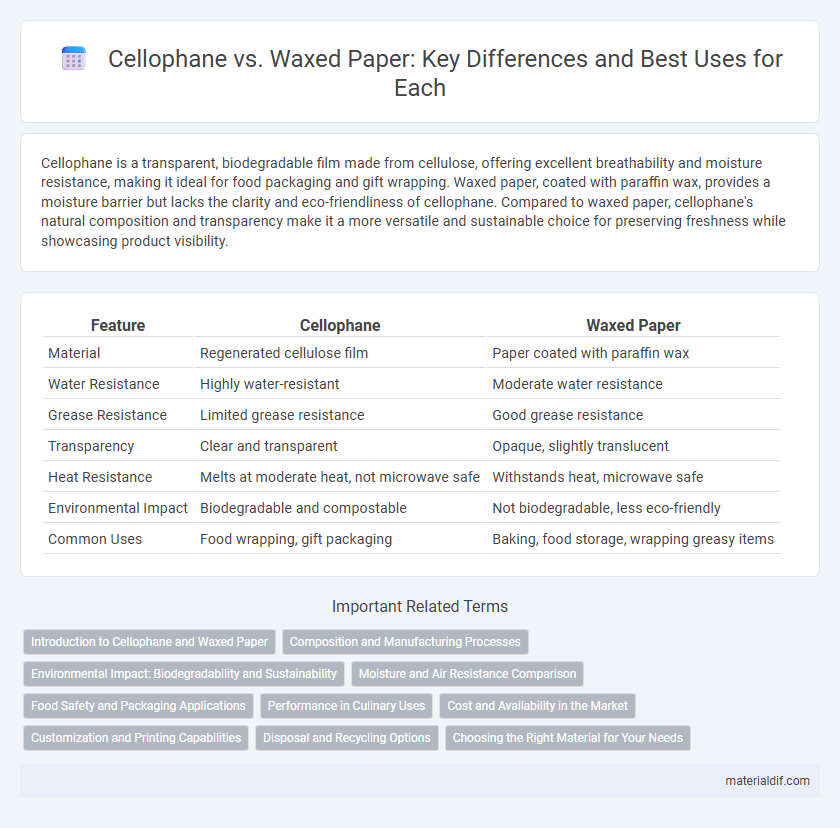Cellophane is a transparent, biodegradable film made from cellulose, offering excellent breathability and moisture resistance, making it ideal for food packaging and gift wrapping. Waxed paper, coated with paraffin wax, provides a moisture barrier but lacks the clarity and eco-friendliness of cellophane. Compared to waxed paper, cellophane's natural composition and transparency make it a more versatile and sustainable choice for preserving freshness while showcasing product visibility.
Table of Comparison
| Feature | Cellophane | Waxed Paper |
|---|---|---|
| Material | Regenerated cellulose film | Paper coated with paraffin wax |
| Water Resistance | Highly water-resistant | Moderate water resistance |
| Grease Resistance | Limited grease resistance | Good grease resistance |
| Transparency | Clear and transparent | Opaque, slightly translucent |
| Heat Resistance | Melts at moderate heat, not microwave safe | Withstands heat, microwave safe |
| Environmental Impact | Biodegradable and compostable | Not biodegradable, less eco-friendly |
| Common Uses | Food wrapping, gift packaging | Baking, food storage, wrapping greasy items |
Introduction to Cellophane and Waxed Paper
Cellophane is a thin, transparent film made from cellulose, commonly used for food packaging due to its moisture resistance and clarity. Waxed paper is a paper product coated with a thin layer of wax, providing a non-stick, moisture-resistant surface ideal for wrapping and protecting food. Unlike waxed paper's opaque texture, cellophane offers superior visibility, making it a popular choice for showcasing packaged items.
Composition and Manufacturing Processes
Cellophane is composed of regenerated cellulose derived from wood pulp, undergoing a chemical process called viscose treatment that dissolves cellulose and then regenerates it into thin transparent sheets. Waxed paper consists of regular paper coated with paraffin or soybean-based wax, providing moisture resistance without transparency. The cellophane manufacturing process includes cellulose purification, xanthation, dissolution, regeneration, and stretching, while waxed paper production involves paper bleaching, drying, and a wax coating application.
Environmental Impact: Biodegradability and Sustainability
Cellophane is a biodegradable film made from cellulose, which decomposes naturally and has a lower environmental footprint compared to waxed paper, often coated with non-biodegradable paraffin wax. Cellophane's renewable origin and compostability contribute to its sustainability advantages, while waxed paper disposal can lead to persistent waste in landfills. Choosing cellophane supports eco-friendly packaging by reducing plastic pollution and promoting resource-efficient materials.
Moisture and Air Resistance Comparison
Cellophane offers superior moisture resistance compared to waxed paper, effectively protecting food from humidity and prolonging shelf life. Unlike waxed paper, which is coated with a thin layer of wax that repels some moisture but remains permeable to air, cellophane creates a nearly airtight barrier that significantly reduces oxygen transmission. This enhanced moisture and air resistance makes cellophane ideal for packaging perishable items requiring freshness and crispness.
Food Safety and Packaging Applications
Cellophane offers superior breathability and moisture resistance compared to waxed paper, making it a safer choice for food packaging by reducing the risk of bacterial growth and preserving freshness. Unlike waxed paper, which can release chemicals when heated, cellophane is made from natural cellulose and is generally considered more food-safe for direct contact applications. Its transparency and ability to create airtight seals provide clear advantages in packaging baked goods, sandwiches, and produce while maintaining hygienic standards.
Performance in Culinary Uses
Cellophane offers superior breathability and moisture resistance compared to waxed paper, making it ideal for wrapping fresh produce and baked goods to maintain crispness and prevent sogginess. Waxed paper's non-stick surface excels in tasks like lining pans and rolling out dough, but it is less effective at preserving food texture due to limited air permeability. The choice between cellophane and waxed paper in culinary uses depends on the desired balance between moisture control and non-stick properties.
Cost and Availability in the Market
Cellophane is generally more expensive than waxed paper due to its biodegradable properties and manufacturing process, affecting overall cost efficiency for businesses. Waxed paper is widely available and cost-effective, making it a preferred choice for everyday household and commercial use. Market availability varies with cellophane often found in specialty stores, while waxed paper is consistently stocked in most supermarkets and retail outlets.
Customization and Printing Capabilities
Cellophane offers superior customization and printing capabilities compared to waxed paper, allowing for high-resolution printing with vibrant colors and detailed graphics. Its smooth, transparent surface enhances ink adhesion, making it ideal for personalized branding and packaging designs. Waxed paper, with its matte and porous texture, limits printing quality and customization options, primarily serving as a protective wrapping rather than a design medium.
Disposal and Recycling Options
Cellophane is biodegradable and compostable, making it an eco-friendly disposal option compared to waxed paper, which is often coated with polyethylene and difficult to recycle. Waxed paper typically ends up in landfill due to its plastic coating, whereas cellophane breaks down naturally and can be processed in industrial composting facilities. Choosing cellophane supports sustainable waste management by reducing plastic pollution and enhancing recycling efficiency.
Choosing the Right Material for Your Needs
Cellophane offers a breathable, biodegradable option ideal for wrapping fresh produce and gifts, preserving moisture without trapping condensation. Waxed paper provides a moisture-resistant barrier perfect for baking and food storage but is less eco-friendly due to its paraffin coating. Selecting between cellophane and waxed paper depends on whether you prioritize breathability and environmental impact or moisture resistance and heat tolerance.
Cellophane vs Waxed Paper Infographic

 materialdif.com
materialdif.com